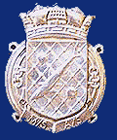|
Sweeping out of
Harwich and Sheerness we went through our baptism of fire, so to speak,
detonating our first magnetic mines. In what was literally a graveyard
of ships, we continually passed the visible wrecks of the Dutch liner
SIMON BOLIVAR, the Japanese liner TERUKINI MARU, the British destroyer
GIPSY and others, all recently sunk by magnetic mines. Shortly we were
dispatched to Dover, where a large number of merchant vessels, unprotected
by degaussing, were immobilised at anchor in the Downs, and that first
night we could see the parachutes of descending mines dropped by enemy
aircraft. We weighed anchor at dawn and thereafter detonated a fair
number of magnetic mines. One large freighter we passed on an outward
leg had only some wreckage to show on our return, having swung at anchor.
Then came two trips to Zeebrugge. On the second, we swept
the harbour at first light in order to enable blockships to be sunk
at the canal entrance, the capture of the town being imminent. Dunkirk
came next with all that entailed. I remember volunteering for our small
boat crew, lowered to search for survivors from a bombed ship sunk during
the night, my Aldis signalling lamp making an efficient portable searchlight
for locating survivors, many of whom were in bad shape. We made two
trips, on both occasions crammed to the gunwhale with exhausted British
and French troops.
I recall an odd occurrence which took place during that
particular period. In the middle of the English Channel, we had spotted
a life size replica of a cockerel actually standing on the surface of
the water and moving over the waves. We picked him up and found that
his legs were fixed to timber wreckage, and he was obviously a survivor
from a sunken vessel. Further to receiving a resplendent coating of
colours, he took pride of place thereafter as our mascot, standing proudly
facing ahead on our bridge platform. Our skipper departed thereafter
to sail a converted whaler from Ardrossan to the Middle East, where
he was subsequently awarded the DSC.
After the fall of France, CLYTHNESS was to be permanently
based at Dover, which had become the nearest place in Britain to enemy
occupied territory. As we could be spotted from the French coast in
fair weather whilst sweeping the war channel, we were liable to be bombed
and straffed by enemy aircraft, once being straddled by a stick of bombs
even with fighter protection, low cloud base being the problem. As a
consequence, sweeping required to be carried out during hours of darkness.
Strong tides and the proximity of the Goodwin sands combined once to
find a sweeping partner requiring a tow from the latter by the tug LADY
BRASSEY from Dover.
Then came the first shelling from heavy artillery sited
on the French coast. The trawlers which formed the majority of sea-going
vessels in the harbour were instructed to depart, only for the gunfire
to follow us towards the direction of Ramsgate. At 23 miles distant,
no accuracy could be achieved, but from then on over the next two years,
a shell would be intermittently dropped into the harbour area. CLYTHNESS
received a near miss on two occasions. On one there were no casualties
as all the crew were below decks. On the other our Steward was killed
instantly, and our Cook received serious injury, the only persons on
deck level when the shell exploded. Each time our ship was heavily riddled
with shrapnel above the water-line.
|








